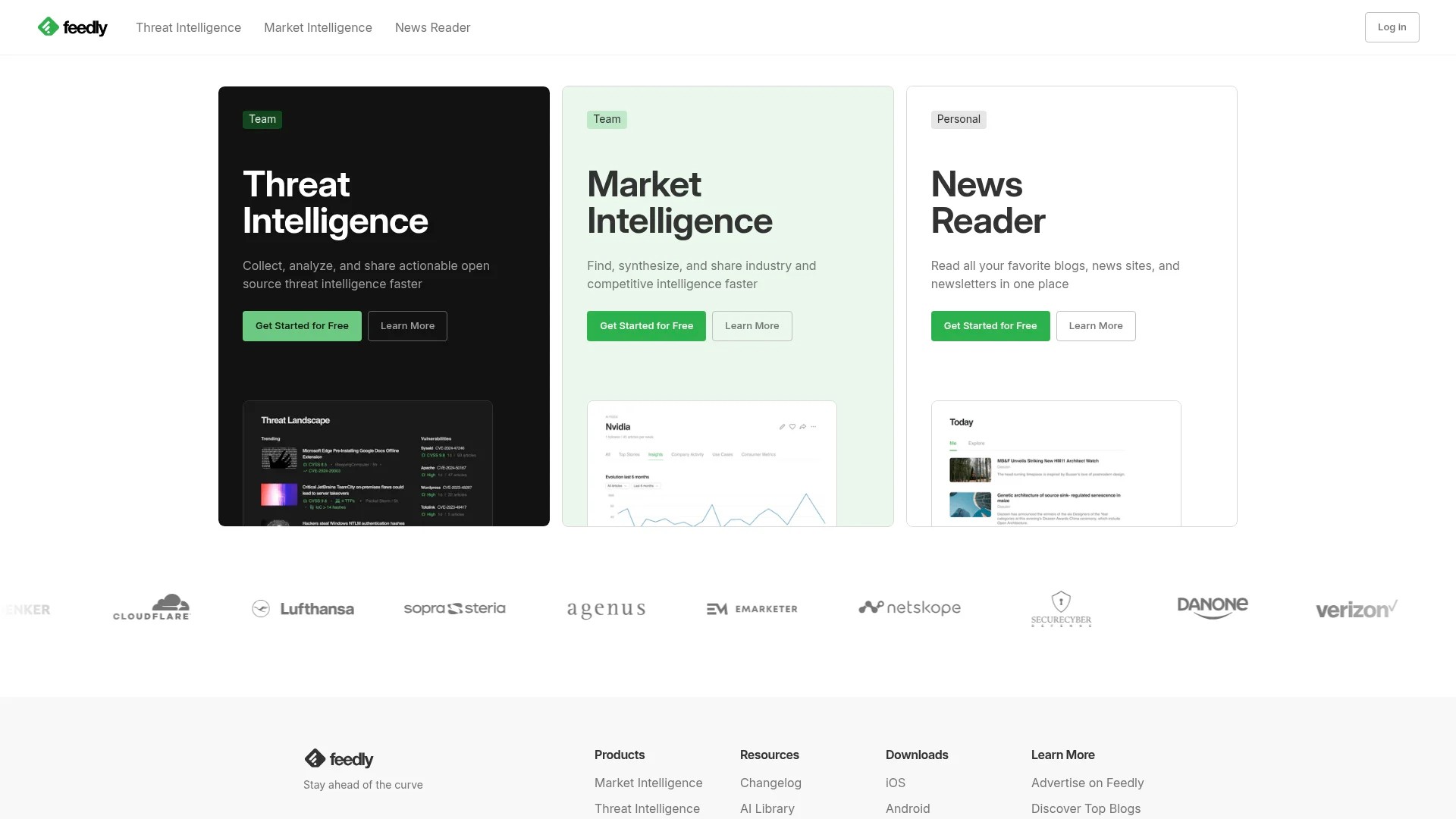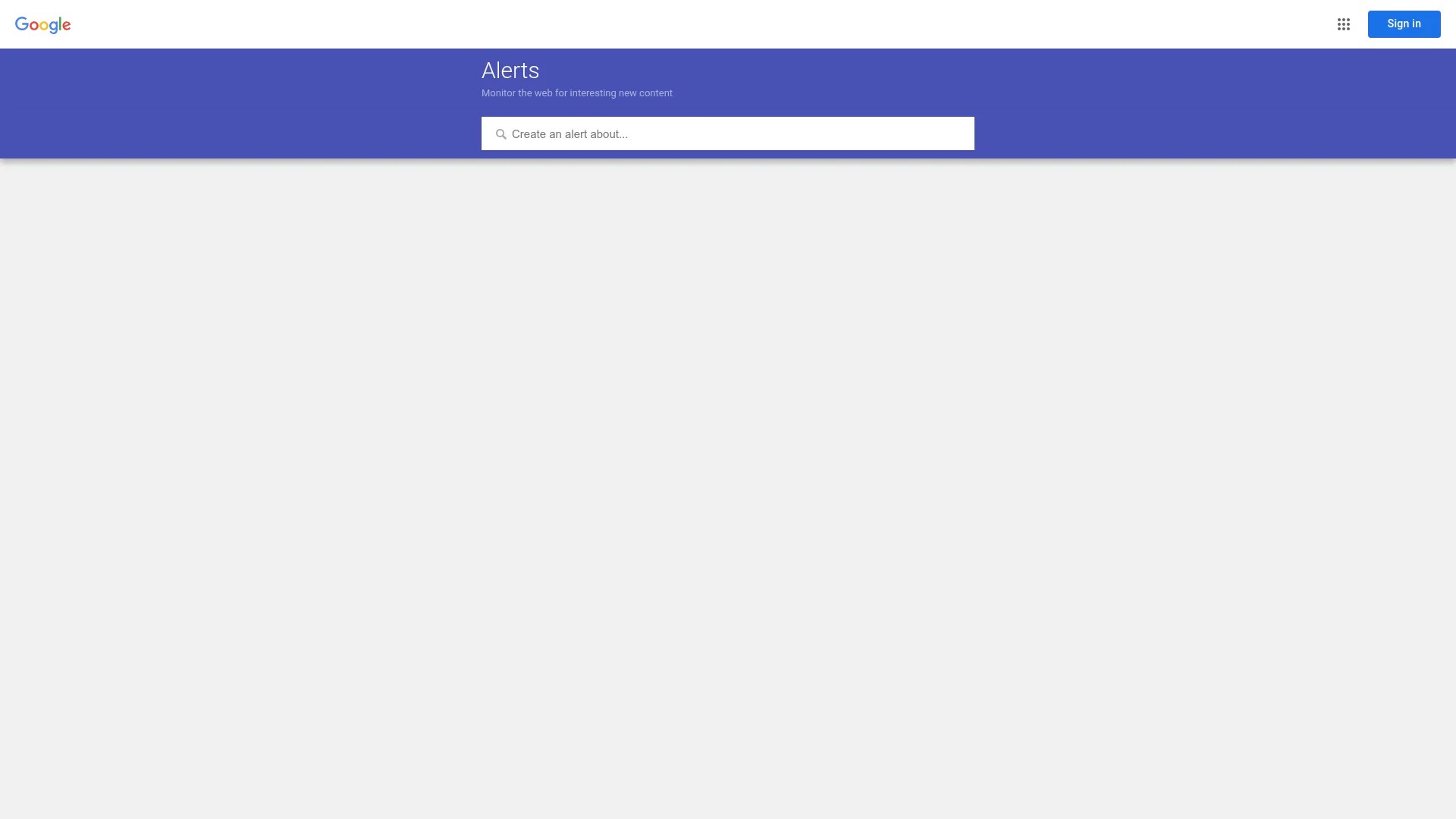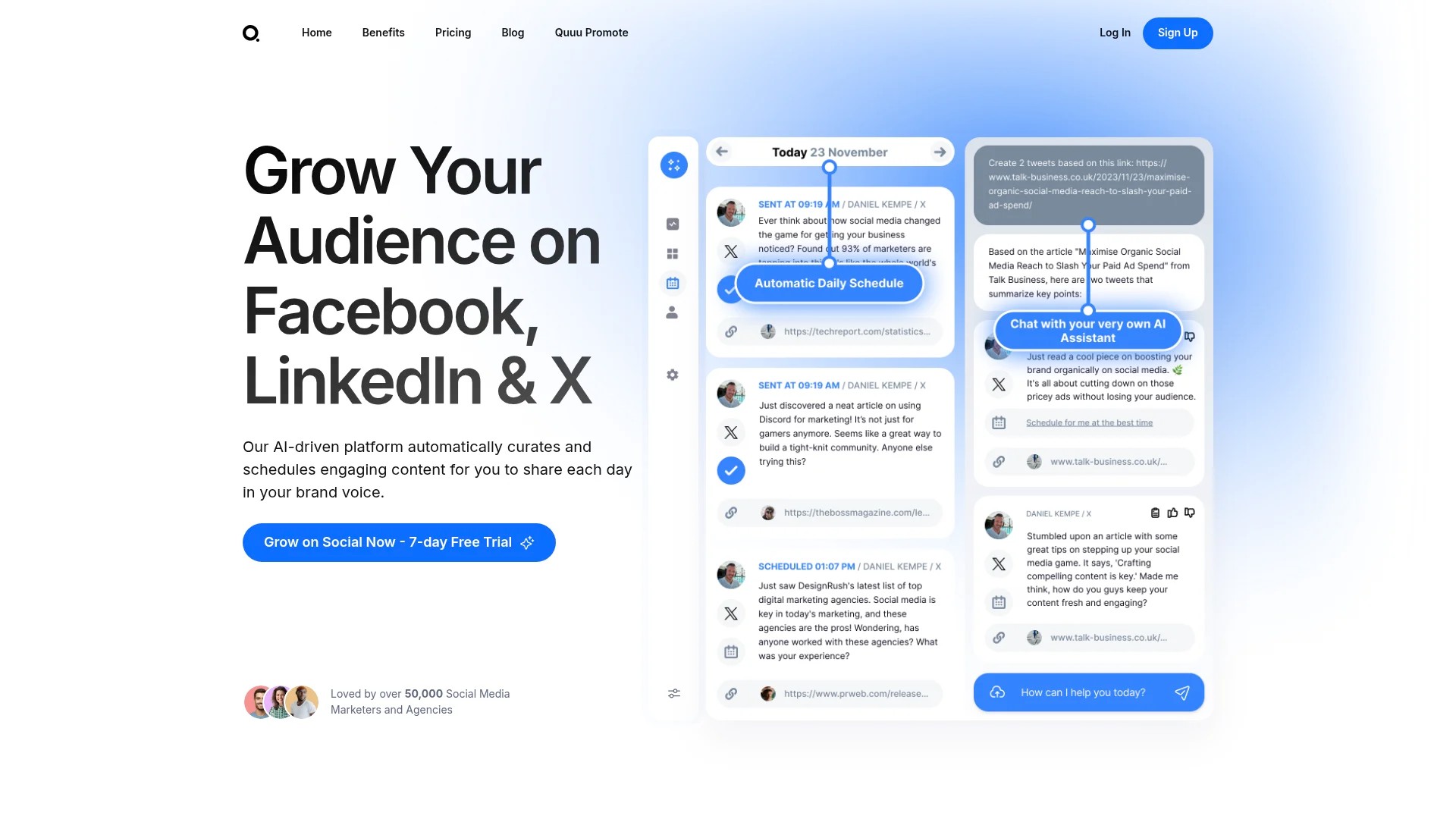Your content strategy needs both curated and promotional posts working together. The most effective approach involves sharing valuable third-party content whilst strategically positioning your brand offerings.
A content marketing strategy should include a curated content approach that complements original and promotional posts. This balance builds trust through educational value whilst maintaining commercial objectives.
Many marketers struggle to find the right mix. They either overwhelm audiences with constant sales messages or never mention their products at all.
This guide provides a practical framework for developing a curated content strategy that enhances your marketing efforts. You’ll discover how to identify valuable sources, create consistency in your posting schedule, and measure what’s working.
What is Content Curation and Why It Matters
Content curation involves selecting and sharing relevant third-party content with your audience. This differs from content creation, where you produce original material from scratch.
The process requires identifying high-quality articles, videos, and resources that align with your audience’s interests. You then share these materials through your channels with appropriate context and commentary.
The Core Value of Curated Content
Curated content strategies drive engagement and build authority within broader content marketing efforts. This approach demonstrates your expertise by filtering valuable information for your audience.
Your target audience appreciates when you save them time. They don’t need to search through countless sources themselves.
Curation also positions you as a trusted resource rather than just a seller. This credibility makes promotional posts more effective when you do share them.

Content Curation Versus Content Creation
Content creation demands significant time investment. You research, write, edit, design, and publish original material.
Content curation streamlines this process. You discover existing quality content and share it with your unique perspective.
Most successful content strategies combine both approaches. Original content showcases your unique insights whilst curated content keeps your channels active between major publications.
| Aspect | Content Creation | Content Curation |
|---|---|---|
| Time Investment | High – requires research, writing, editing | Moderate – requires discovery and selection |
| Expertise Required | Deep subject matter knowledge | Strong filtering and judgement skills |
| Consistency | Challenging to maintain frequency | Easier to sustain regular posting |
| Brand Authority | Establishes thought leadership | Demonstrates industry awareness |
| Audience Trust | Builds through original insights | Grows through valuable recommendations |
Building Your Content Curation Strategy Foundation
A successful curated content strategy starts with understanding what your audience needs. This foundation determines which third-party content deserves your attention and your audience’s time.
Identifying Your Target Audience Needs
Your audience consumes content to solve specific problems. Document these challenges in detail before selecting any curated material.
Create audience personas that outline:
- Primary pain points they face daily
- Information gaps preventing their progress
- Preferred content formats and channels
- Decision-making processes they follow
- Industry trends affecting their work
Survey your existing community regularly. Ask what topics they want more information about and which sources they already trust.
Setting Clear Curation Goals
Define what success looks like for your content curation efforts. These goals guide your selection criteria and measurement approach.
Common content curation objectives include:
- Maintaining consistent publishing frequency
- Building credibility in specific topic areas
- Keeping your audience informed about industry changes
- Supporting your promotional content with educational context
- Reducing content production costs
Assign specific metrics to each goal. Track engagement rates, audience growth, and how curated content supports your promotional post performance.
Establishing Your Brand Voice in Curation
Your commentary on curated content should sound distinctly like your brand. This consistency helps audiences recognize your posts immediately.
Develop guidelines for how you introduce third-party content. Some brands use questions to spark discussion whilst others provide brief summaries with key takeaways.
Your brand perspective transforms curation from simple sharing into valuable interpretation. Always add context explaining why this content matters to your specific audience.
Analysing Your Competitive Landscape
Understanding what competitors share helps you identify gaps and opportunities. This competitive analysis shapes your differentiation strategy.
Mapping Competitor Content Approaches
Audit five to ten competitors’ content strategies over a thirty-day period. Document the ratio of promotional to educational posts they publish.
Notice which topics they cover repeatedly and which they ignore completely. These patterns reveal audience interests and overlooked opportunities.
Track engagement metrics when possible. High-performing competitor posts indicate topics your shared audience cares about deeply.
Identifying Content Gaps
Your competitive research reveals questions nobody answers thoroughly. These gaps represent your best curation opportunities.
Look for:
- Emerging trends competitors haven’t addressed
- Complex topics explained poorly elsewhere
- Audience questions left unanswered in comments
- Practical implementation guides that don’t exist
Position your curated content to fill these voids. When you consistently address overlooked topics, you become the go-to resource.
Differentiating Your Curation Approach
Avoid simply resharing the same articles as everyone else. Your curation strategy needs distinctive elements that make your selections valuable.
Consider organizing content around unique themes or frameworks. Some successful curators focus on contrarian perspectives whilst others synthesize multiple sources into comprehensive roundups.
Your commentary style also differentiates your curation. Develop a consistent approach to introducing articles, whether through provocative questions, personal insights, or practical applications.
Discovering and Selecting Quality Content Sources
Effective content curation depends on reliable source discovery methods. Building a systematic approach ensures you never run out of valuable material to share.
Building Your Source Network
Identify authoritative publishers in your industry. These sources consistently produce high-quality, relevant content worth sharing with your audience.
Start with industry publications, thought leaders’ blogs, and research organisations. Add academic journals, government resources, and trade associations to your list.
Organise these sources by topic and reliability. This categorisation helps you quickly find relevant content when planning your publishing schedule.
Essential Tools for Content Discovery
Several platforms streamline content curation by aggregating sources and highlighting trending topics. These tools save significant time in your discovery process.
Consider these content curation platforms:
- Feedly organises RSS feeds by topic and priority
- Google Alerts notifies you about specific keywords
- Buffer helps schedule and manage social sharing
- Quuu suggests relevant content matched to your audience
- Scoop.it provides topic-focused content recommendations
Set up daily or weekly review sessions using these tools. Consistent monitoring ensures you never miss important industry developments.
Evaluating Content Quality and Relevance
Not every article deserves your audience’s attention. Develop clear criteria for selecting third-party content that aligns with your brand standards.
Ask these questions before sharing any content:
- Does this solve a specific problem my audience faces?
- Is the information accurate and well-researched?
- Does the source have credibility in this topic area?
- Is the content timely and relevant right now?
- Can I add valuable context or commentary?
Reject content that contradicts your brand values or confuses your audience. Quality beats quantity in content curation strategies.
Creating Your Posting Balance Framework
The right mix of curated and promotional posts depends on your industry, audience, and business goals. This framework helps you determine your ideal balance.
Understanding Optimal Content Ratios
Most effective content strategies follow ratio guidelines that prioritise audience value whilst maintaining commercial presence. Common approaches include the 80-20 rule or the 5-3-2 method.
The 80-20 approach dedicates 80% of posts to valuable, educational content (including curated material) and 20% to promotional messages. This builds trust whilst maintaining sales opportunities.
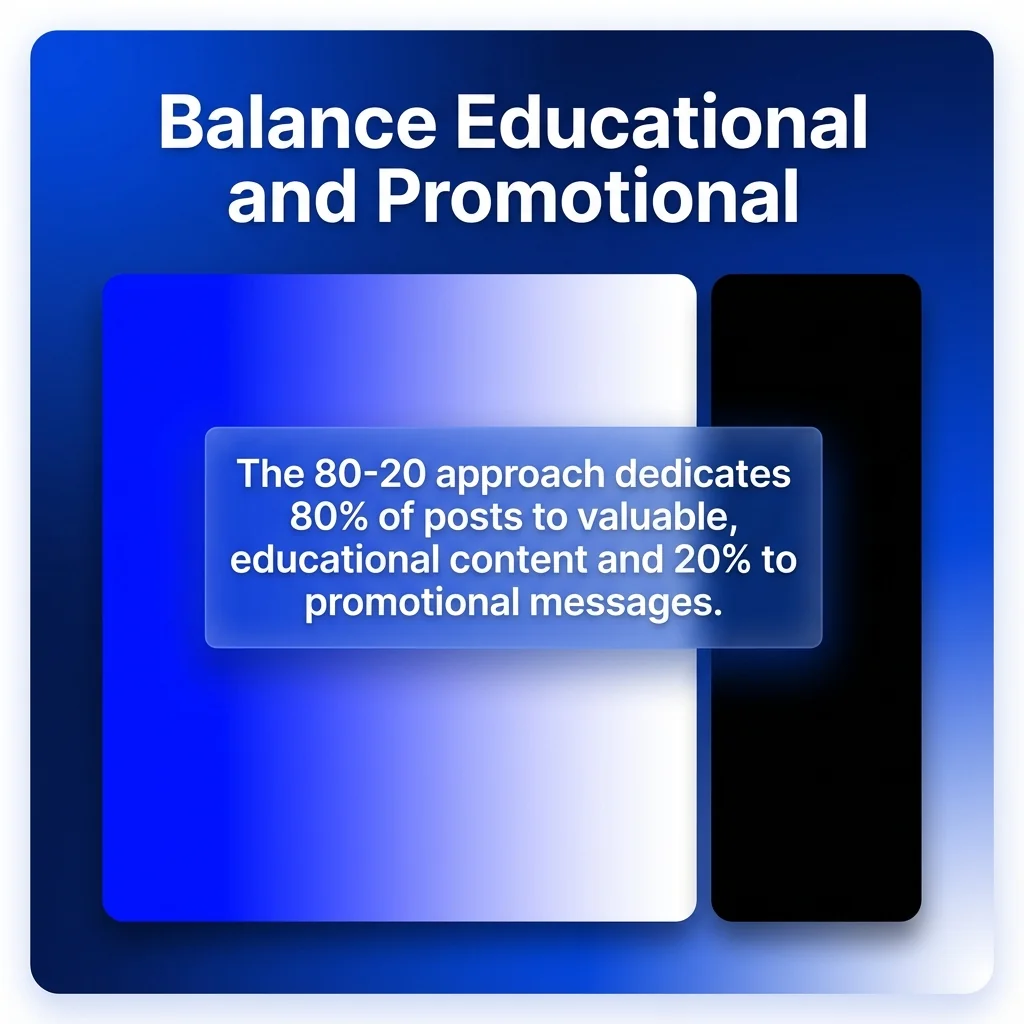
The 5-3-2 method distributes ten posts as: five pieces of curated content, three original pieces, and two promotional posts. This ensures variety and consistent value delivery.
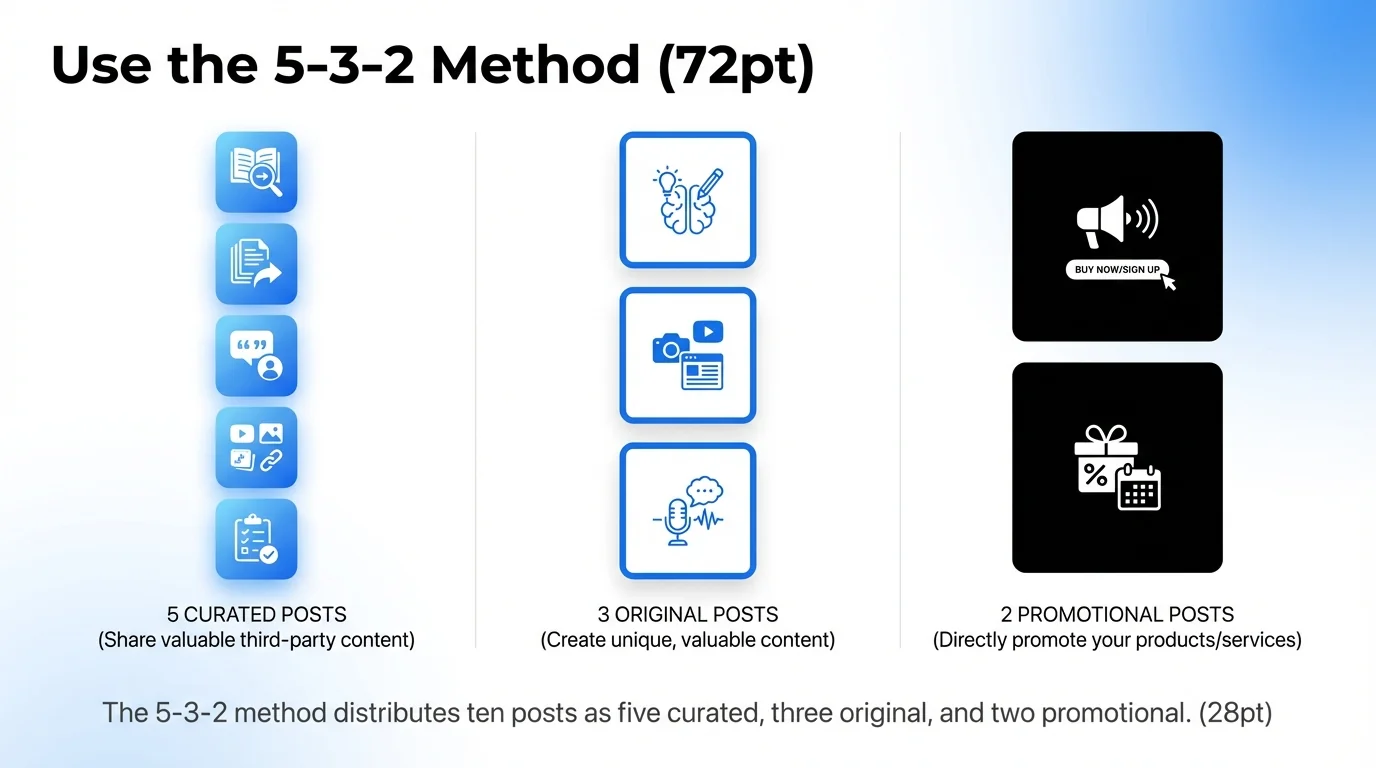
| Framework | Curated Content | Original Content | Promotional Posts |
|---|---|---|---|
| 80-20 Rule | 60% | 20% | 20% |
| 5-3-2 Method | 50% | 30% | 20% |
| Value-First | 50% | 40% | 10% |
Adapting to Platform and Audience Expectations
Different platforms require different content balances. LinkedIn audiences tolerate more professional promotional content whilst Twitter users prefer conversational sharing.
Test your ratios over thirty-day periods. Track engagement rates, follower growth, and conversion metrics for each content type.
Adjust based on performance data rather than assumptions. Some audiences respond well to higher promotional frequency whilst others disengage quickly.
Planning Your Content Calendar
A well-structured content calendar ensures consistent posting whilst maintaining your desired balance. This planning prevents last-minute scrambling and maintains quality standards.
Develop a monthly calendar that includes:
- Curated content slots with topic themes
- Original content publication dates
- Promotional post timing aligned with campaigns
- Buffer slots for timely industry news
- Review and adjustment periods
Schedule curated content during quieter periods when original content production slows. This maintains consistent audience engagement throughout the month.
For detailed guidance on structuring your posting schedule, review our guide on creating the perfect social media content calendar for 2025.
Adding Value Through Commentary and Context
Simply sharing links without perspective provides minimal value. Your commentary transforms curated content from generic sharing into valuable curation.
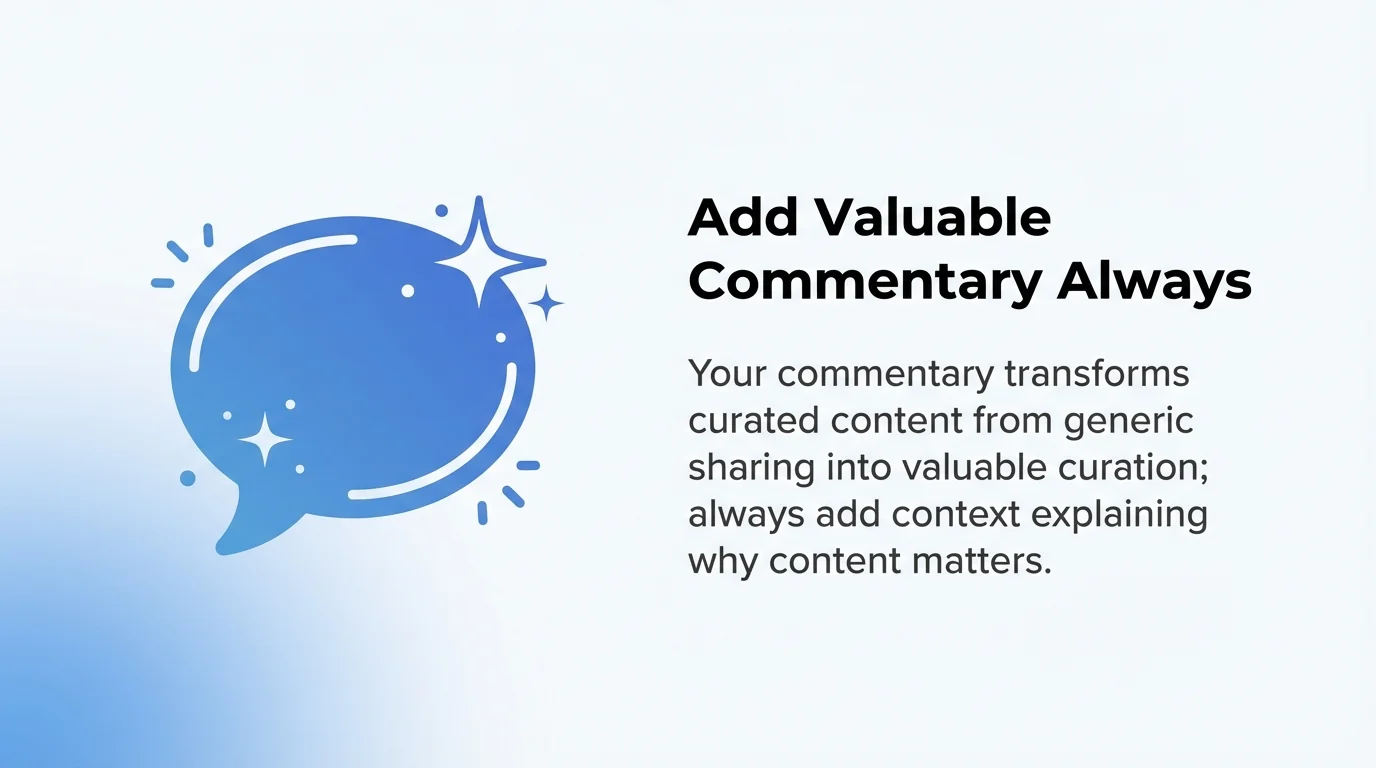
Developing Your Curation Voice
Your unique perspective on third-party content distinguishes your curation from simple aggregation. This voice reflects your expertise and brand personality.
Consistent commentary approaches include:
- Highlighting key insights audiences might miss
- Connecting articles to current industry challenges
- Questioning assumptions in the source material
- Providing implementation tips based on the content
- Relating concepts to your audience’s specific context
Develop templates for different commentary styles. This structure maintains consistency whilst allowing flexibility for different content types.
Maintaining Brand Alignment
Every piece of curated content reflects on your brand. Ensure third-party materials align with your values and messaging standards.
Review content for tone, accuracy, and perspective before sharing. Even excellent articles might contradict your brand positioning or confuse your audience.
Your commentary should bridge any gaps between the source content and your brand perspective. Acknowledge different viewpoints whilst maintaining your position.
Giving Proper Credit and Attribution
Always credit original content creators clearly. This practice maintains ethical standards and builds relationships with industry peers.
Include author names, publication sources, and direct links to original articles. Never present curated content as your own creation.
Tag authors and publications when sharing on social platforms. This courtesy often leads to engagement from creators and expanded reach through their networks.
Learn more about effective content curation practices in our comprehensive guide to the six parts of a content curation strategy.
Integrating Promotional Posts Strategically
Promotional content succeeds when it complements rather than disrupts your value-focused curation. Strategic integration maintains audience trust whilst achieving commercial objectives.
Timing Your Promotional Messages
Space promotional posts between value-driven content to maintain audience goodwill. Clustering multiple sales messages creates negative impressions and drives unfollows.
Consider these timing approaches:
- Follow educational content series with related product mentions
- Share promotions during natural decision-making windows
- Time sales messages to align with audience pain points
- Avoid promotional posts during sensitive industry moments
Track when your audience shows highest engagement. Schedule promotional content during these peak periods for better visibility and response.
Creating Value-Added Promotional Content
The best promotional posts solve problems whilst showcasing your offerings. This approach blends education with commercial messages naturally.
Structure promotional content as:
- Case studies demonstrating real results
- Tutorials using your products to solve challenges
- Comparisons helping audiences make informed decisions
- Behind-the-scenes content building connection
Even direct product announcements should highlight audience benefits rather than just features. Frame every promotional message around solving specific problems.
For practical examples of how to balance promotional and value-driven posts, explore our collection of non-promotional content examples.
Measuring Promotional Effectiveness
Track how promotional posts perform relative to curated and original content. This data guides ratio adjustments and messaging improvements.
Monitor these promotional content metrics:
- Engagement rates compared to educational posts
- Click-through rates to product pages
- Conversion rates from social traffic
- Follower growth or loss following promotions
- Comments and sentiment analysis
Adjust your promotional frequency and approach based on audience response. Some communities tolerate higher promotional ratios whilst others require more restraint.
Measuring Success and Optimising Your Strategy
Effective content curation requires ongoing measurement and adjustment. Regular analysis ensures your strategy continues delivering value to both audience and business objectives.
Key Performance Indicators for Curated Content
Track metrics that reflect both audience engagement and business impact. These measurements guide strategic decisions about content selection and sharing frequency.
Monitor these essential metrics:
| Metric Category | Specific Measurements | Success Indicators |
|---|---|---|
| Engagement | Likes, shares, comments per post | Curated content performs within 80% of original content rates |
| Reach | Impressions, follower growth | Steady audience expansion without significant unfollows |
| Traffic | Click-through rates, website visits | Increasing referral traffic from social channels |
| Authority | Mentions, tags from industry leaders | Growing recognition as valuable curator |
| Conversions | Leads, sales from curated content days | Maintained conversion rates despite less promotional content |
Testing and Adjusting Your Content Mix
Run structured experiments with different content ratios. These tests reveal what balance works best for your specific audience and goals.
Try these testing approaches:
- Alternate weeks with different promotional frequencies
- Compare engagement across content types monthly
- Test various commentary styles on curated posts
- Experiment with posting times for each content category
Document results systematically. Small adjustments based on data often yield significant performance improvements over time.
Refining Your Source Selection
Some sources consistently generate better engagement than others. Identify these high-performers and prioritise them in your curation workflow.
Track which publishers, authors, and content formats resonate most with your audience. Gradually shift towards these preferred sources whilst maintaining topic diversity.
Remove underperforming sources from your regular rotation. This refinement improves overall content quality and audience satisfaction with your curation.
For more strategies to enhance your content curation approach, explore our article on eight content curation strategies that drive results.
Common Challenges and Practical Solutions
Every content curator faces obstacles when implementing a balanced strategy. These practical solutions address the most frequent challenges marketers encounter.
Maintaining Consistency Without Burnout
Content curation demands regular effort. Without systems in place, the process becomes overwhelming and consistency suffers.
Implement these sustainability practices:
- Batch your content discovery into weekly sessions
- Build a content queue with pre-selected articles
- Use scheduling tools to automate posting
- Create commentary templates for efficiency
- Set realistic posting frequencies you can maintain

Quality matters more than quantity. Posting three excellent curated pieces weekly beats daily sharing of mediocre content.
Avoiding Over-Promotion Whilst Meeting Goals
Sales targets create pressure to increase promotional frequency. This tension threatens the value balance your audience expects.
Address this challenge by making promotional content more valuable. Educational product posts, detailed case studies, and problem-solving tutorials serve both audience needs and business objectives.
Track how promotional frequency affects overall engagement. If sales posts reduce total reach significantly, you’re losing more potential customers than you’re gaining.
Standing Out in Crowded Content Spaces
Popular industry topics get shared repeatedly by multiple sources. Your curation needs distinctive elements to capture attention.
Differentiate through these approaches:
- Curate content from unexpected sources outside your immediate industry
- Combine multiple perspectives into synthesis posts
- Focus on niche subtopics competitors ignore
- Share older, evergreen content that remains valuable
- Develop unique frameworks for organizing curated material
Your expert commentary provides the primary differentiation. Even widely-shared articles become unique when viewed through your specific expertise lens.
Review our collection of curated content examples to see how successful brands maintain distinctiveness whilst sharing third-party material.
Quick Answers to Common Questions
What is a content curation strategy?
A content curation strategy is a systematic approach to collecting, selecting, and organising relevant content from various sources to share with a target audience. This strategy aims to provide value by filtering and presenting high-quality information that aligns with audience interests and organisational goals.
What are the three pillars of content curation?
The three pillars of content curation are discovery, organisation, and sharing. These pillars represent the process of finding valuable content, structuring it for clarity, and distributing it to the right audience to maximise impact.
What are the 5 C’s of curation?
The 5 C’s of curation typically refer to collecting, categorising, critiquing, curating, and circulating content. These steps ensure that curated materials are relevant, well-organised, thoughtfully evaluated, and effectively shared with the intended audience.
Moving Forward with Your Balanced Strategy
Balancing curated and promotional posts requires ongoing attention and adjustment. Start with established ratio frameworks, then adapt based on your audience’s specific responses.
Your content strategy succeeds when it serves both audience needs and business objectives simultaneously. Curated content builds trust and authority whilst promotional posts convert that goodwill into tangible results.
Begin by auditing your current content mix. Calculate the percentage of promotional versus educational posts you currently share.
Then implement these immediate actions:
- Set up content discovery tools this week
- Define your target content ratio based on industry benchmarks
- Create a thirty-day content calendar balancing all post types
- Develop commentary templates for efficient curation
- Schedule monthly reviews to assess performance and adjust
Success comes from consistent execution and data-driven refinement. Your balanced approach will strengthen audience relationships whilst supporting your commercial goals effectively.
For additional guidance on building comprehensive content strategies, explore our resource on powerful marketing strategy examples that demonstrate effective content balance in action.

